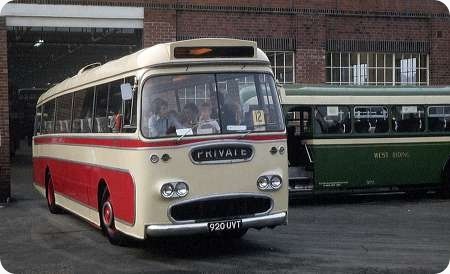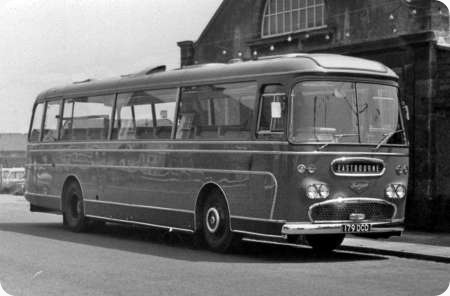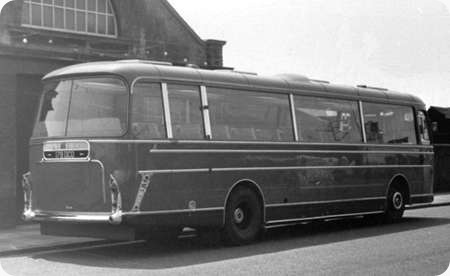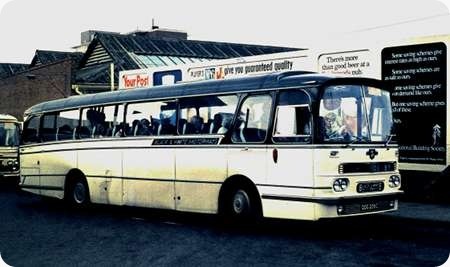
Potteries Motor Traction
1962
Leyland Leopard PSU3/3R
Plaxton Panorama C48F
C920 was one of a batch of five Leyland Leopard coaches to the recently permitted 36ft length delivered in 1962.
They were used on tours until 1968 when they were modified for one man operation which included fitting the roof mounted destination box. During my time at PMT they were allocated to Hanley Depot where they were reasonably suited to the longer distance services such as Hanley – Sandbach, Hanley – Crewe etc but not good on the more urban routes. My recollection is heavy steering, heavy clutch and heavy gear change – in fact they were just a heavy vehicle! The next batch of coaches were Reliance 590s, a much more lively and lighter vehicle to drive. (That should suit David O)!
The photo is taken in the preservation era on 9th September 1979 at the West Riding 75th Anniversary Rally at Belle Isle Depot in Wakefield. The programme records it as recently acquired by the Potteries Omnibus Preservation Society – I wonder if it is still around?
Photograph and Copy contributed by Ian Wild
08/09/13 – 08:30
You know me so well, Ian. Maybe that’s the real reason SUT got 333? Did it escape from an intended batch of six for PMT? Not only were they heavy, heavy, heavy, they had that low cramped driving position and – care of gear ratios – slow. I commuted regularly on the X48 to Manchester and initially it was on North Western’s early Y types on the same chassis. Only once did I get the feeling that they could be good with a driver who managed to DRIVE the thing – keeping the thing in third at the CORRECT revs and storming over the hills on Woodhead. Being an AEC man doesn’t prevent me saying that the Leopard eventually developed in its later years into a good coach – but they never got the ratios right on the standard Pneumo-cyclic box.
David Oldfield
PS: The roof box looks like one of those virtual reality head sets.
09/09/13 – 06:41
David’s comments about North Western’s early Y types is interesting. I regularly rode on those as a teenager on the X5 services to and from London and from a passenger’s point of view they were certainly lively enough on the flat and the more gentle gradients.
I also rode Western Scottish’s versions to and from Glasgow. The A6 over Shap and A74 over Beattock never seemed to present a problem, even when having to get around some fairly slow moving eight wheelers from Southall and Leyland which, when laden and often drawing a trailer, would really struggle.
Given Ian’s recollections regarding the heavy handling of the vehicle, it strikes me as a little odd that North Western, as a keen user of both AEC and Leyland, put all its coach eggs in the Leyland basket from the early 1960s onwards with the Leopard as the chosen chassis.
Phil Blinkhorn
09/09/13 – 09:00
The only area where the early Leopards were superior to the AEC was that they went in the direction you turned the wheel, where as the AEC’s had a tendency to wander. But you’re right about the later Leopard’s David, however, an AEC Reliance with a six speed ZF would knock spots off any Leopard, perhaps that’s why BL ‘not Leyland Motors’ killed if off?
Ronnie Hoye
09/09/13 – 14:15
SUT’s drivers hated 333 [it was the same age and identical to PMT C920] for the reasons stated. The next Leopards only arrived, in the mid ’70s, after NBC take over. I drove a 1976 example with a subsequent owner and was agreeably surprised by how it performed. By then a higher driving position, power steering and the 5 speed pneumo-cyclic box (not to mention a bigger engine) had addressed a number of the earlier criticisms. Ian’s (and SUT’s) criticisms were widespread but the Leopard did have some virtues – but maybe more for the engineer than the driver. It was, to quote a Commercial Motor journalist who was/is also an operator, a reliable plodder. When I once put Phil’s question to a North Western driver he said, "Well the Leopard – especially semi-auto – is nigh on idiot proof but not every one can drive a six speed ZF." Chris Y and Ian will agree that a ZF is not difficult if you drive properly (that is sensitively) but I know people, who ought to know better, who can’t! Lots of Leopard coaches had two speed rear axles. I always find these fun. There’s a sense of achievement using the splitter well – and this no doubt helped the performance of early Leopards. If you were a Leyland fleet, there was no doubt enough to keep you faithful – but I preferred the (Ribble) Leyland engined REs on the Manchester – Scotland services.
David Oldfield
10/09/13 – 16:30
I was still at Percy Main the first time I encountered an AEC Reliance with a ZF box, a Duple bodied demonstrator turned up, and those of us who were around at the time were invited to have a drive. We were all experienced with manual boxes, which on occasion required a bit of brut force and ignorance. We sat round for the pep talk, and we were informed that “You don’t need to grab the gear stick, all you need with a ZF is gentle guidance with the palm of the hand, and it will do all the work for you” Guess what? He was dead right.
Ronnie Hoye
11/09/13 – 08:30
As someone who worked for Southdown for nearly 22 years I had experience of various types of Leopard as well as an assortment of East Kent Reliance on South Coast Express work I have to agree with the previous comments.
The Leopard most certainly required considerable muscle to drive the steering and all the pedals were heavy to use although I found the large treadle throttle was comfortable in use and as Ronnie Hoye says the steering had no tendency to wander unlike the Reliance which needed constant attention but was lighter to use.
The two speed axle, which was fitted to all our Leopards both buses and coaches, did indeed help the performance especially on the O.600 engine models on the later O.680 engine models it really boosted the performance, although they were something that needed to be used properly to get the best out of them which sadly all too many drivers didn’t bother to do We had a batch of seven PSU5’s in 1981 which were fitted with a splitter box a much smoother operation, the main difference being that being part of the gearbox it changed as soon as the switch was operated irrespective of throttle position whereas the two speed being part of the rear axle would only change when the throttle was released taking the load off the mechanism, so could be preselected if necessary.
Having said all that about the Leopard I still found the Reliance much more enjoyable to drive the 6 speed box being a delight to use needing only the lightest of touches to get the best from it which after the effort needed on the manual Leopard was such a pleasure the brakes were also much lighter and progressive to use. The engine always felt much more free revving and, more powerful, I only drove one semi automatic Reliance after which I still preferred the manual version.
The later Leopards with 680 engines, pneumocyclic gearboxes and high driving position were indeed much better vehicles but never as good as the 6 speed Reliance
Diesel Dave
11/09/13 – 16:30
Well, I’ve said it before – i) ZF Reliance ii) RELH/REMH – (preferably 6L) iii) TRCTL11 Tiger iv) late Leopard. That is my hall of coaching fame – with apologies to Arab LUF fans. (I neither rode on nor drove any so I cannot have a view!)
David Oldfield
12/09/13 – 08:30
Couldn’t agree more Dave, the Leopard with raised driving position, 680 engine and 5 speed pneumocyclic gearbox made a very good bus or coach.
PMT had 20 Leopard buses delivered 1962/3 with manual gearboxes which weren’t bad vehicles. It was the five coaches converted for omo that just weren’t suited to their new role. The contemporary Reliance 590 buses although better than the earlier 470s still had problems with cylinder head gaskets/cylinder liner seal failures and the hydraulically operated clutches gave a fair degree of trouble. Much easier to steer and change gear on though!
Ian Wild
12/09/13 – 08:30
No need to apologise, David, since we are talking about different eras. I have only ever said that I think the Guy Arab LUF was the finest coach chassis of its time. As for late Leopards and Reliances, the only good thing to come out of the demise of the Reliance was the Leopard with 6-speed ZF gearbox, which is what it should always have had.
Peter Williamson
12/09/13 – 16:30
The 470 and 590 lost AEC a number of friends – despite the 691 and 760 addressing most of the problems – but the ZF Reliance (especially 691/760 powered) was a thoroughbred. Leyland still didn’t get it quite right, though, Peter.
The ZF used on the Reliance was an overdrive unit (5th was direct), that used on the Leopard had a direct 6th. [Rather like the strange unit used on the X reg Midland Scottish Leopards. Ostensibly a 5 speeder with CAV change (ie like Monocontrol and not the normal Westinghouse pedestal), it was more like a 4 speeder with a crawler below 1st. I drove one in preservation and it was odd to be able to start regularly in "3rd".
David Oldfield
11/08/14 – 17:32
AEC vs Leyland at North Western
Engineering staff at Macclesfield always told me they mistrusted AECs for always blowing gaskets. Leylands more friendly to maintain.
Bob Bracegirdle
06/03/21 – 07:09
During the early/mid 80s I travelled on National express coaches nearly every other weekend. They were mainly Leyland Leopard coaches, usually with 680s and the 5 speed air assisted box. Some did have 2 speed axles, but these were much rarer. The coaches had a. Huge gap between 4th and 5th, which affected there performance on motorway inclines, as the vehicle had to reduce speed to 50-55mph to change down. This was always where others coaches such as the Volvo B10s would come past. However, on the flat, many of these coaches would easily reach 80mph for long periods.
I once travelled on a Leopard with an early TL11 and air assisted box with twin speed axle, that was the fastest coach I ever travelled on. It only dipped to 70mph on the inclines not 55 and powered past the Volvo models by 5-10mph. It also held 80 on the flat.
Seems bizarre thinking of coaches going that fast, but at the time they would often been in the outside lane on the motorway going as fast they were capable of with the driver with his foot on the boards. The Leopards sounded great at speed, and growling around the London Victoria and Digbeth stations.
Amazing times.
Dr Chris Davies
13/03/21 – 06:36
I seem to recall that the restriction of coach/bus speed limits on motorways was because of a spate of minor accidents, then a biggy, when a coach went off the motorway and down some some sort of large drain vertically, killing a lot of pensioners. I think it was near Bristol. I think it took a while because they had to get the whole of the EU to agree the limits and a fair time for vehicles with speed governors to come along.
Chris Hebbron
15/03/21 – 06:30
I think the accident that Chris is referring to is this one:- www.independent.co.uk/
Nigel Frampton
15/03/21 – 13:36
The very one, Nigel. Thx for raking that out. Memory not so bad, after all. Now then, what was I going to do next??? Um!
Chris Hebbron




